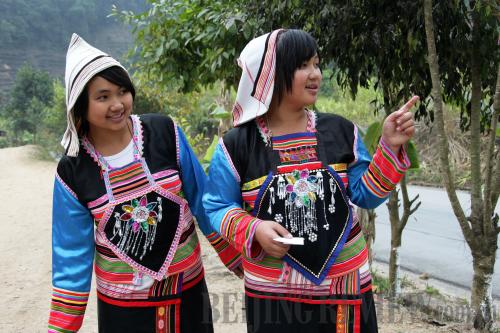|
The Jinuo minority group has a population of more than 20,000. Since the group has its own spoken language but no written language, students learn Mandarin Chinese at school and speak in their native tongue at home. To preserve Jinuo's language and culture, the local government recorded the spoken language and sponsored some of the group's gatherings and customs.
Most of China's ethnic minority groups are found in the western region. According to China's policies related to minority groups, children receive a free education and bilingual teaching is provided in regions where the minority group has its own written language, such as in Xinjiang and Tibet.
The Chinese Government has emphasized the importance of education by building a number of vocational schools, training bases and internship bases since 2000. From 1999 to 2007, the number of colleges and universities in the region increased from 251 to 467, and new enrollment and the number of registered students increased 2.9 times and 3.6 times, respectively.
Rural and urban areas have seen their healthcare service system develop rapidly since the implementation of the development strategy, which has led to improvements in healthcare quality. According to NDRC statistics, the number of beds in medical care facilities reached 1.08 million and medical professionals increased to 1.5 million, up 32.1 percent and 6.4 percent, respectively, from 1999.
To raise the healthcare standard in the western region, a disease prevention and control system and a medical rescue system for public health event were established alongside 16,440 township health centers and 180,000 village clinics. The efforts have shown successful results—the infant mortality rate and maternal mortality rate have decreased remarkably and about 85 percent of the rural population is now covered by the new rural cooperative medical system.
From 2000 to 2008, the Central Government allocated 60 billion yuan ($8.78 billion) to reduce the region's impoverished population, cutting the number from 57.3 million to 26.5 million. The reduction accounted for 56.9 percent of the nationwide total during the same period.
Industrial and agricultural growth
 |
|
AFFORDABLE EDUCATION: Zhou Xiaoting (left) and Zhou Xiaole, two sisters of the Jinuo minority group, walk along a road near their hometown in Yunnan Province. The Western Development Strategy allows the sisters to study at a vocational school tuition-free and lead a life similar to their urban counterparts (WANG XIANG) |
Frequent droughts and an obsolete agricultural production mode once forced Ningxia to import grain from neighboring provinces and regions. But now, Ningxia's per-capita grain production is 536.2 kg and the region has become one of five in China that produces more than 500 kg grain per capita. Ningxia has since become self-sufficient with its grain needs.
The Central Government's call for improvements to agricultural production conditions as part of the Western Development Strategy has helped modernize agriculture at the local level. Ningxia responded by promoting water-efficient agriculture and protected agriculture, a method of growing crops in a controlled environment.
Ningxia's new agricultural production mode has been replicated in other western provinces and autonomous regions.
NDRC statistics from the past 10 years show output increases of major agricultural and pastoral products, as well as the stable development in the western region's agricultural and rural economies.
The gross output value of the farming, forestry, animal husbandry and fishing sectors reached nearly 1.5 trillion yuan ($220 billion) in 2008, increasing 911 billion yuan ($133.4 billion) from 2000, or 158.3 percent, while grain output rose 8.5 percent from 129 million tons in 2000 to 140 million tons in 2008.
Animal husbandry accounted for a majority of the region's agricultural production, with meat, egg and milk production increasing by 24 percent, 39 percent and 357.8 percent, respectively.
The industrial sector has also picked up steadily. According to the Ministry of Industry and Information Technology, the added value of the industrial sector in the western region was 2.25 trillion yuan ($329.4 billion) in 2008. The region realized a sustained annual growth of 22.96 percent in average from 1999. According to NDRC statistics, the industrial added value accounted for 38.7 percent of the region's GDP and 47.7 percent of GDP growth in 2008, increasing from 19.5 percent and 25.7 percent in 2000, respectively.
While relying on its unique resources and making use of its comparative advantages, the western region has formed some competitive industries with local characteristics, according to the NDRC's Western Development Office. The dairy industry and cashmere products of Inner Mongolia, tobacco production of Yunnan, sugar making of Guangxi, quality cotton growing and fruit and vegetable processing of Xinjiang all have received a boost from the strategy, says the office.
Other provinces or regions are enjoying competitive advantages in raw material production, such as lead and zinc in Gansu and Yunnan, vanadium and titanium in Sichuan, rare earth in Inner Mongolia, potash fertilizer in Qinghai, and phosphorus fertilizer in Guizhou.
Ecological action
"In accordance with the Western Development plan, we took the lead in launching the natural forestry protection engineering project," said Wei Hong, Vice Governor of Sichuan.
The project has covered 19.2 million hectares of natural forests in the past few years. The province has also reclaimed 1.85 million hectares of forests from farmlands and 5 million hectares of grasslands from grazing lands, Wei said. Currently, the province has 123 natural reserves, accounting for 15.8 percent of the province's total area, and boasts a forest coverage area of 30.8 percent, 6 percentage points higher than in 2000.
"Projects, such as reclaiming forests or grasslands from farmlands, and natural forest protection, are a requirement of the Western Development Strategy and through these measures we aim to improve the local environment and prevent further damage to the ecosystem," according to a statement by the Western Development Office of the NDRC. | 